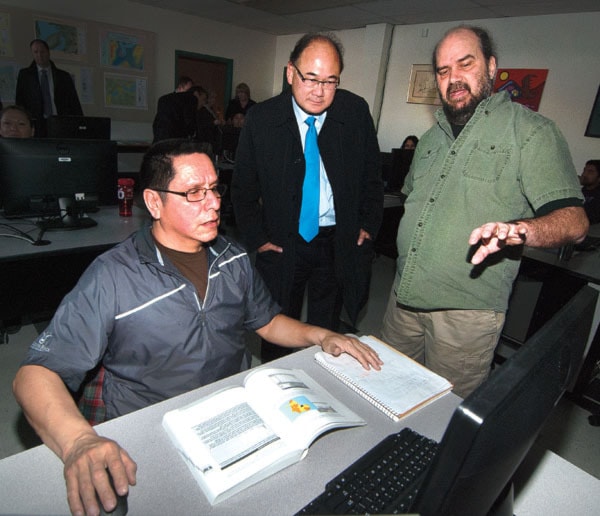Fifteen First Nations students from around the province are learning how geographical information systems (GIS) can benefit them and their bands.
The 500 hours of training over a 20-week period is based on a course that has been offered at Okanagan College for many years, says instructor Mitch Krupp.
The course was moved to the Vernon campus when Krupp and his family relocated to Ontario. Back in the Shuswap late last summer, Krupp began providing one-week, “whet-your-appetite” courses to First Nations groups in B.C.
“As a result of doing that, we found funding through a Vancouver organization called the First Nations Technology Council (FNTC),” he says. “HRDC (Human Resources Development Canada) gave them money for technology-based funding for First Nations.”
While computer courses were included, Krupp approached the council with a proposal to provide the full course at the Salmon Arm campus for First Nations only – something he’s been trying to do for many years.
As a result, 15 students, including four young women, from several B.C. communities including Salmon Arm, are on their way to becoming GIS technicians.
“We have a full class,” says an enthusiastic Krupp. “We’ve never had a full class in the 13 years it’s been running.”
This course has been modified to address unique First Nations GIS applications, some of which are more complex, Krupp adds.
Although their training will prepare them for positions with government or industry as well, Krupp says their focus is usually narrower, with perhaps one or two applications only.
“In the band, they have several departments that can benefit from GIS and will be using it a lot more,” he says of the technology that is currently being used for background work in treaty negotiations and can apply to fisheries and protecting habitat, among others.
One of the most important and most interesting says Krupp with enthusiasm, is using the technology to sit down with elders and record their knowledge of traditional uses – where their ancestors fished and hunted, where they gathered bark and berries etc. and displaying the material on maps.
“It’s very interesting, and getting this information captured is important,” Krupp says. “They’ve realized this is a gold mine of information relevant to their lives.”
In order to approve funding to the tune of $7,600 in tuition per student, FNTC had to get approval from Human Resources Development Canada because one of their funding requirements is that participants be employed within two months following training.
Krupp says a number of students have jobs lined up with their bands and FNTC will be working with other to ensure their success in getting jobs.
He says the First Nations Council and the college spent many hours working on the logistics of getting the students, many of whom are young and have never been away from home, places to stay in Salmon Arm.
“It’s all new to them,” laughs Krupp, noting the students are responsible for their cost-of-living expenses and have had their eyes opened by having to acquaint themselves with new experiences such as buying groceries.
That they are coping well in the classroom is evidenced by Krupp’s enthusiasm.
“I’ve been doing this since 1998 and this is probably the most enthusiastic group ever. They get along really well, they’re positive about it, they’re excited about it,” he says. “It’s a pleasure to be working with them. It’s just been a dream group. They know they’re being given something quite unique.”
Krupp says HRDC funding is being rolled out over a three-year period and if all goes well, he’s hoping to be able to offer the First Nations course for the next two winters as well.
By that time, he believes the course will have gained a first-class reputation and that students from First Nations across the country will be coming to the college’s Salmon Arm campus every January.
“Hopefully, if it builds a reputation as being a top-notch GIS training course, then it will have momentum built and we’ll find other sources of funding,” he says, noting he’s had requests to take the course elsewhere but is determined to keep it at the college.
In the meantime, Krupp is also delighted that the regular GIS program will return to the Salmon Arm and under his wing this fall.
